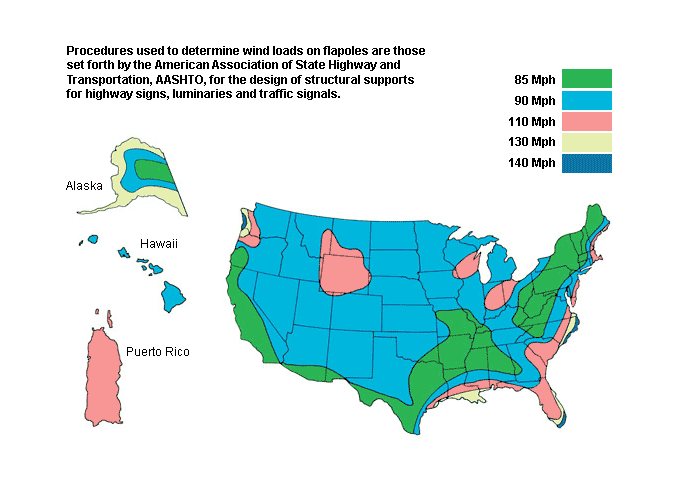The chart below shows the maximum steady wind expected at an elevation of thirty feet above ground level within a fifty-year period of recurrence. Areas with the same maximum constant or steady wind speed are indicated. Because wind speeds are usually not constant, and gust are involved, flagpoles are listed with a constant wind speed and with a 1.3 gust factor.

Design of safe flagpoles requires knowledge of the loads to which the will be subjected. Principle load acting on flagpoles is wind load and that load must be carefully determined. Maximum wind speeds to which flagpoles are exposed depend on geographical location, whether or not it is in the center of a large city, a small town’s outskirts, seashore, at ground level or on the roof of a high building. Wind speeds generally are higher along the coastal areas than inland.
Wind exerts a force on the pole as well as the flag, thus both loads must be added to determine total load. Obviously, it is important that flagpoles be selected which are capable of supporting the largest flag intended to be flown in the highest wind speed to which it will be subjected. Loads on flagpoles are resisted by the mounting foundation, roof or wall to which it is secured.
Wall Mounting Flag Kits | Commercial Flagpoles | Telescoping Flagpoles | 20ft In Ground Flagpoles | Solar Flagpole Lights | Flag Pole Accessories | Residential Flagpoles | About our Flagpoles | Garden Flag Poles & Flags | Flag Poles by Height | Wind Speed Chart
Didn't find what you were looking for, or just have a new product suggestion? Please email us at: FlagProductSuggestion@OnlineStores.Com
Copyright © 2009 Online Stores Inc. All Rights Reserved.